Spring, summer, or fall annuals are some of the most prolific bloomers around, and they make showy additions to garden beds and window boxes. But if you’re looking to add an extra pop of color to your front porch or sunny back patio, you may want to consider keeping trailing annuals in hanging baskets, too. And luckily, there are tons of colorful options to choose from!
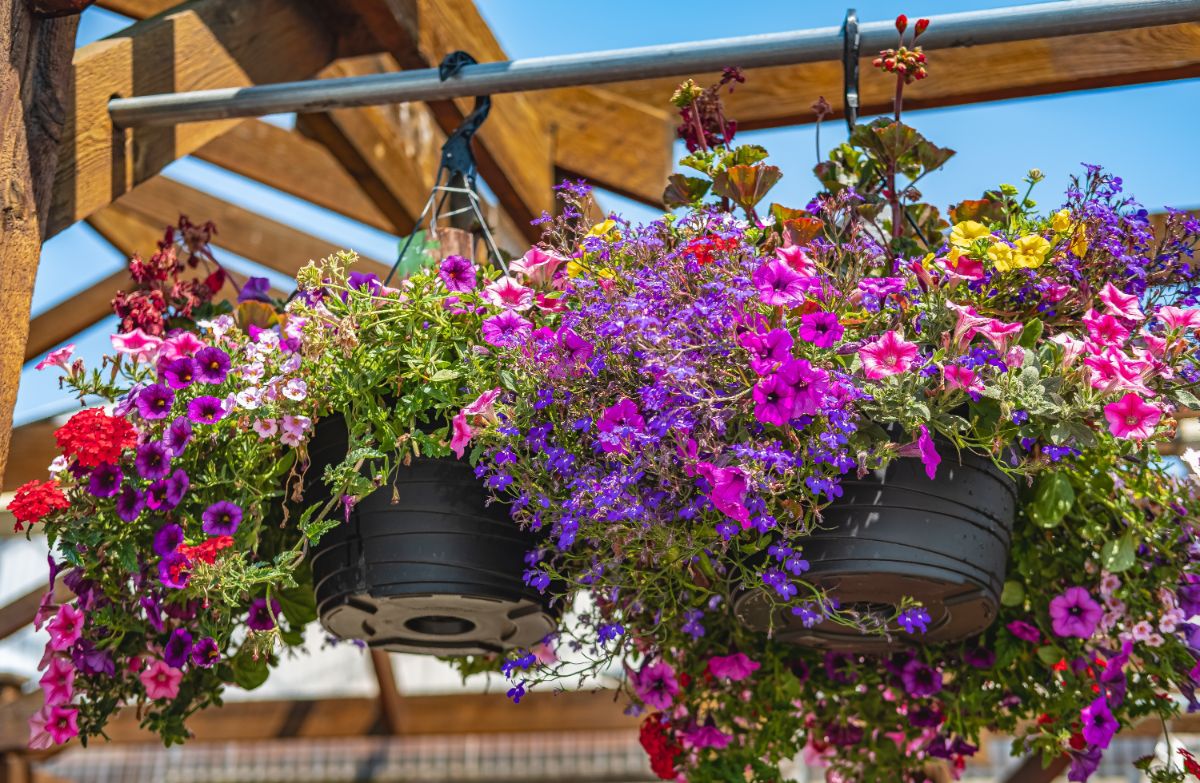
In the list below, you’ll find some of the most flashy, beginner-friendly annuals to grow in hanging pots and baskets. Most of these plants can also be kept in window boxes and porch planters as well, and some of them can even be overwintered indoors as houseplants. If you’re ready to spice up your hanging planters, these annual flowers will do just that!
Jump to:
- 18 best annuals to grow in hanging baskets
- 1. Petunias (Petunia spp.)
- 2. Trailing lobelia (Lobelia erinus)
- 3. Million bells (Calibrachoa spp.)
- 4. Impatiens (Impatiens walleriana)
- 5. Amethyst flower (Browallia speciosa)
- 6. Trailing pansies (Viola x wittrockiana)
- 7. Geraniums (Pelargonium zonale)
- 8. Sweet alyssum (Lobularia maritima)
- 9. Begonias (Begonia spp.)
- 10. Portulaca (Portulaca oleracea)
- 11. Trailing African daisies (Osteospermum fruticosum)
- 12. Lantana (Lantana spp.)
- 13. Mums (Chrysanthemum spp.)
- 14. Fuchsia (Fuchsia magellanica)
- 15. Boston fern (Nephrolepis exaltata)
- 16. Bacopa (Sutera cordata)
- 17. Burro’s tail (Sedum morganianum)
- 18. Asparagus fern (Asparagus setaceus)
- Frequently asked questions
- What can I hang on my front porch instead of flowers?
- How do you hang plants on a porch?
- What hanging plants don't need much water?
- Is there a way to hang plants without drilling?
- What hanging plants can take full sun and heat?
- What hanging plants don't need much sun?
- Summary
18 best annuals to grow in hanging baskets
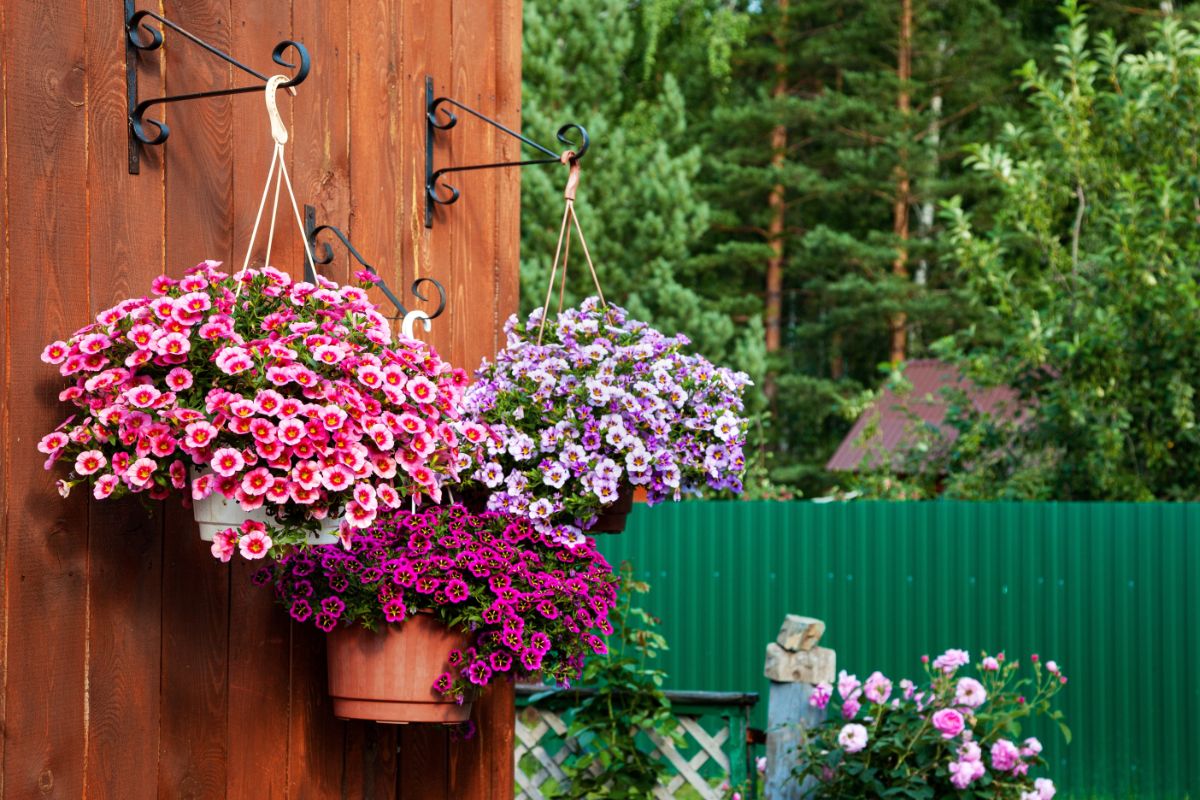
Annuals are plants that don’t survive the winter in your growing region, which means you won’t have to care for annuals during the winter months. However, annuals will typically need to be planted every year unless you move your potted plants indoors when temperatures drop. Conveniently, some of the plants in the list below can grow well indoors as houseplants when you’re not keeping them outdoors in hanging baskets!
1. Petunias (Petunia spp.)
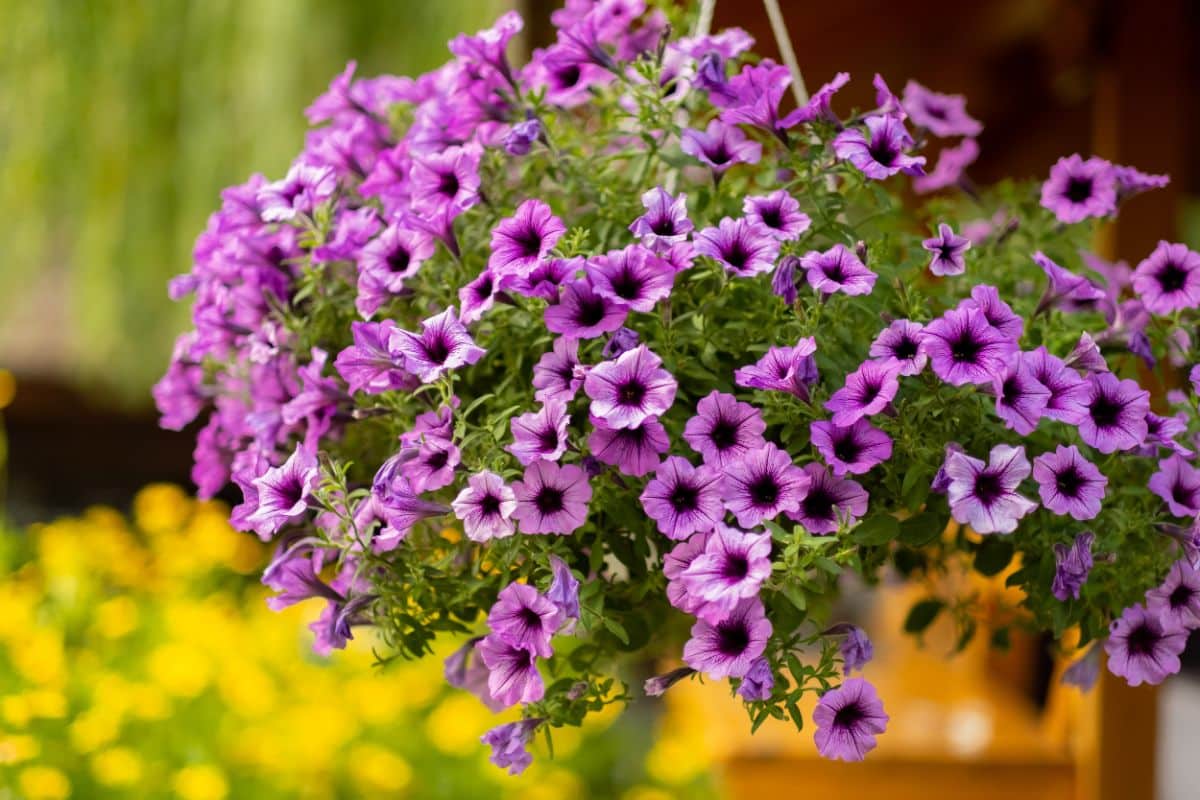
| Plant name: | Petunias |
| Light requirements: | Full sun |
| Water requirements: | Moderate |
| Bloom time: | Spring to frost |
Petunias are one of the most classic plants for hanging baskets, thanks in part to their super low maintenance needs. But petunias are also highly coveted for their colorful, trumpet-shaped flowers, which come in almost any color you could want. Most petunias grow beautifully from late spring until the first frost of autumn, but you can also find Wave Petunias, which are more cold-tolerant than other petunia species.
Petunias benefit from frequent deadheading, which encourages plants to produce more flowers. Pruning or pinching back petunias from time to time will also encourage plants to branch out and produce more leaves and flowers. Depending on your gardening style, you can grow petunias on their own in a hanging basket, or you can mix and match them with other trailing plants, like million bells and trailing pansies.
2. Trailing lobelia (Lobelia erinus)
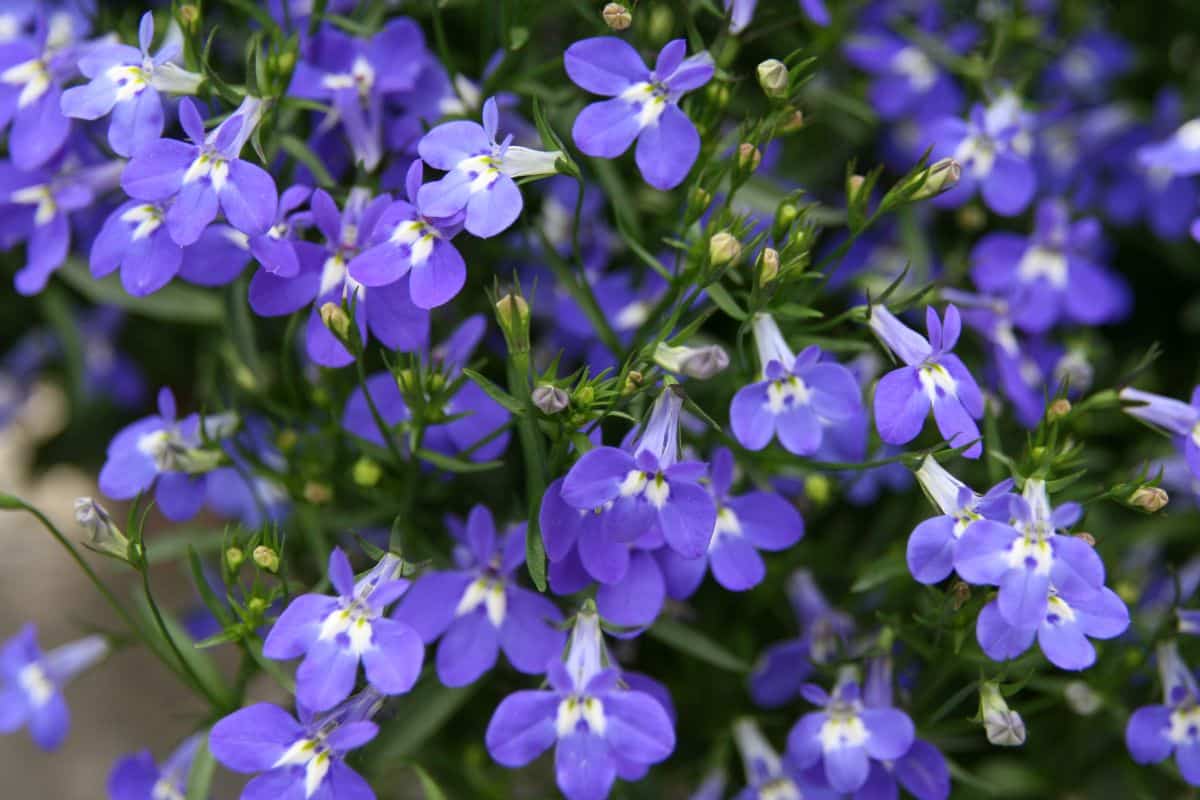
| Plant name: | Trailing lobelia |
| Light requirements: | Full sun to part shade |
| Water requirements: | Moderate |
| Bloom time: | Spring to frost |
There are over 400 different Lobelia species, including the ever-popular blue lobelia and cardinal flowers. But if you’re looking for a trailing plant to keep in hanging baskets, trailing lobelias are the plants you need to grow. These beauties have the delightfully colorful blooms you’ve come to expect from the Lobelia family, but these plants stay more compact and only grow about 6 to 9” high.
Trailing lobelia’s fan-shaped flowers come in many different shades, including white, pink, purple, and blue. These plants can bloom from spring through fall frosts, although their flowers may become more scant during summer heat. Technically, trailing lobelias are perennial plants in zones 10 and 11, but they are grown as annuals in cooler spots.
3. Million bells (Calibrachoa spp.)
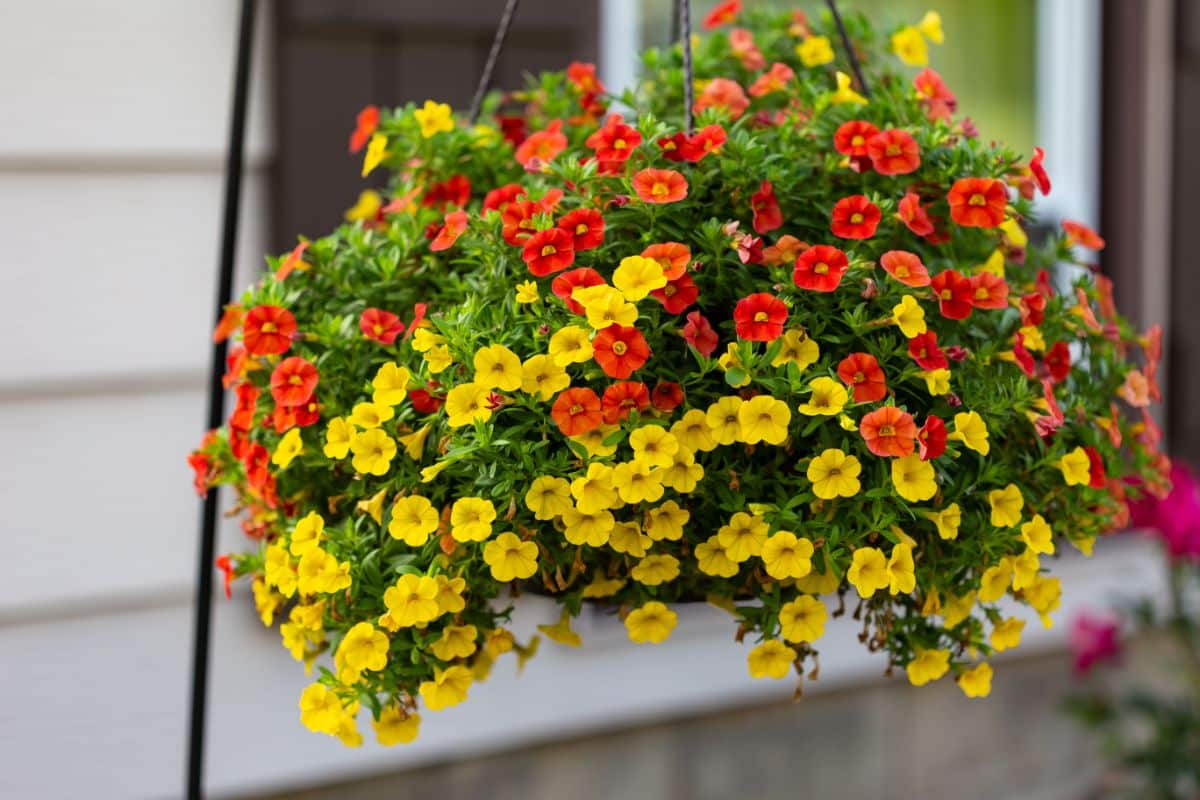
| Plant name: | Million bells |
| Light requirements: | Full sun to part shade |
| Water requirements: | Moderate |
| Bloom time: | Spring to frost |
Also known as trailing petunias, million bells are a relatively new hybrid plant species that was first developed in the 1990s. These plants have trumpet-shaped flowers, which look quite similar to petunia blooms, but they’re significantly smaller and come in different colors. You can find million bells with purple, pink, red, blue, yellow, white, and bronze flowers, and they look dashing when planted with petunias or other trailing plants.
Million bells can grow as perennials in warm locations, but in USDA growing zones 8 and below, million bells are kept as annuals. Compared to petunias, million bells need less frequent deadheading, although you can encourage your plants to grow fuller if you pinch them back from time to time. If you like the idea of keeping million bells and want to propagate more plants, taking stem cuttings is the best way to do it, as these plants rarely produce seeds.
4. Impatiens (Impatiens walleriana)
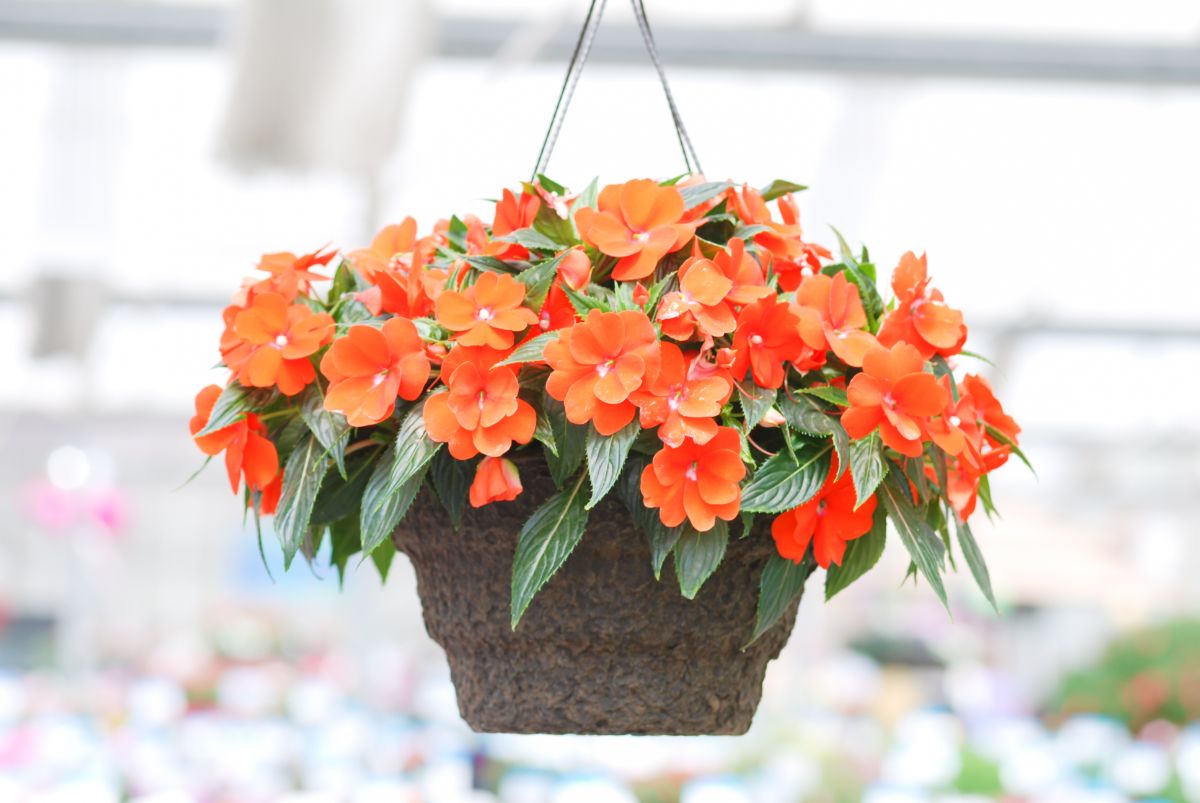
| Plant name: | Impatiens |
| Light requirements: | Shade |
| Water requirements: | High to moderate |
| Bloom time: | Spring to frost |
One of the best plants to grow in shady spots, impatiens are often used as bedding plants in flower gardens, but their spreading nature also makes them exceptional choices for hanging baskets. Technically, a tender perennial, impatiens can survive winters in spots where frost does not occur, but most gardeners keep impatiens as annuals and sow new plants every spring. Impatiens can be grown from seeds or stem cuttings, but rooted plants are also readily available at most plant nurseries.
Like many other plants on this list, impatiens come in an impressive array of colors, although you’re most likely to find impatiens with pink, salmon, violet, or white blooms. As they grow, impatiens produce trailing and succulent stems, which help the plant conserve water. But be warned: impatiens love moisture, and they need to be watered often, particularly when they’re kept in pots!
5. Amethyst flower (Browallia speciosa)
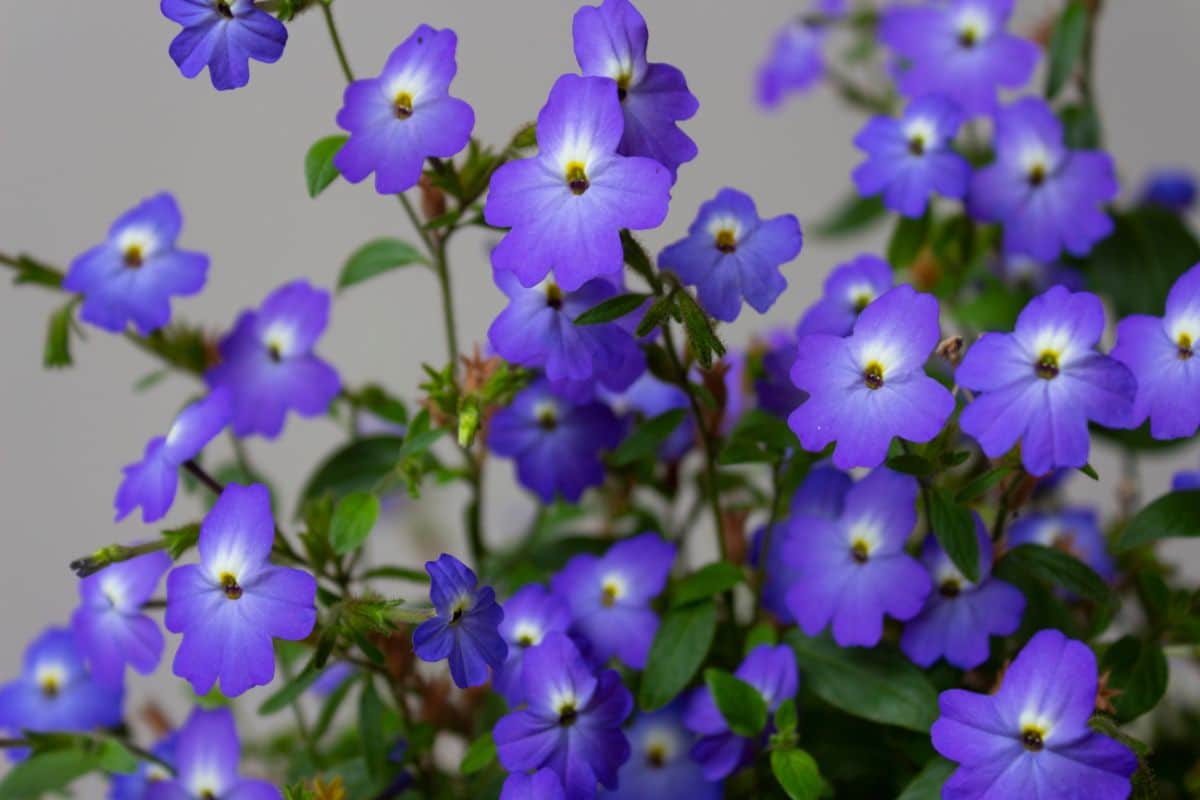
| Plant name: | Amethyst flower |
| Light requirements: | Full sun |
| Water requirements: | Moderate |
| Bloom time: | Late spring to fall |
Also known as browallia, amethyst flowers have bright purple blooms, but you can also find these plants with white or blue flowers too. As they grow, amethyst flowers maintain a cushion-like growth habit, but their trailing stems look stately in hanging baskets and porch planters. Plus, these plants can handle some shade, which makes them a fine choice for growing under shady balcony and porch roofs!
As with other tender perennials, amethyst flower does overwinter in growing zones 10 and 11, but most gardeners keep these plants as annuals. If you’re patient, you can start amethyst flowers from seed, but you’ll get blooms earlier if you plant nursery-started plants instead. Like petunias and million bells, amethyst flowers will grow bushier and produce more flowers if they’re pinched back occasionally, but these plants need very little maintenance other than that.
6. Trailing pansies (Viola x wittrockiana)
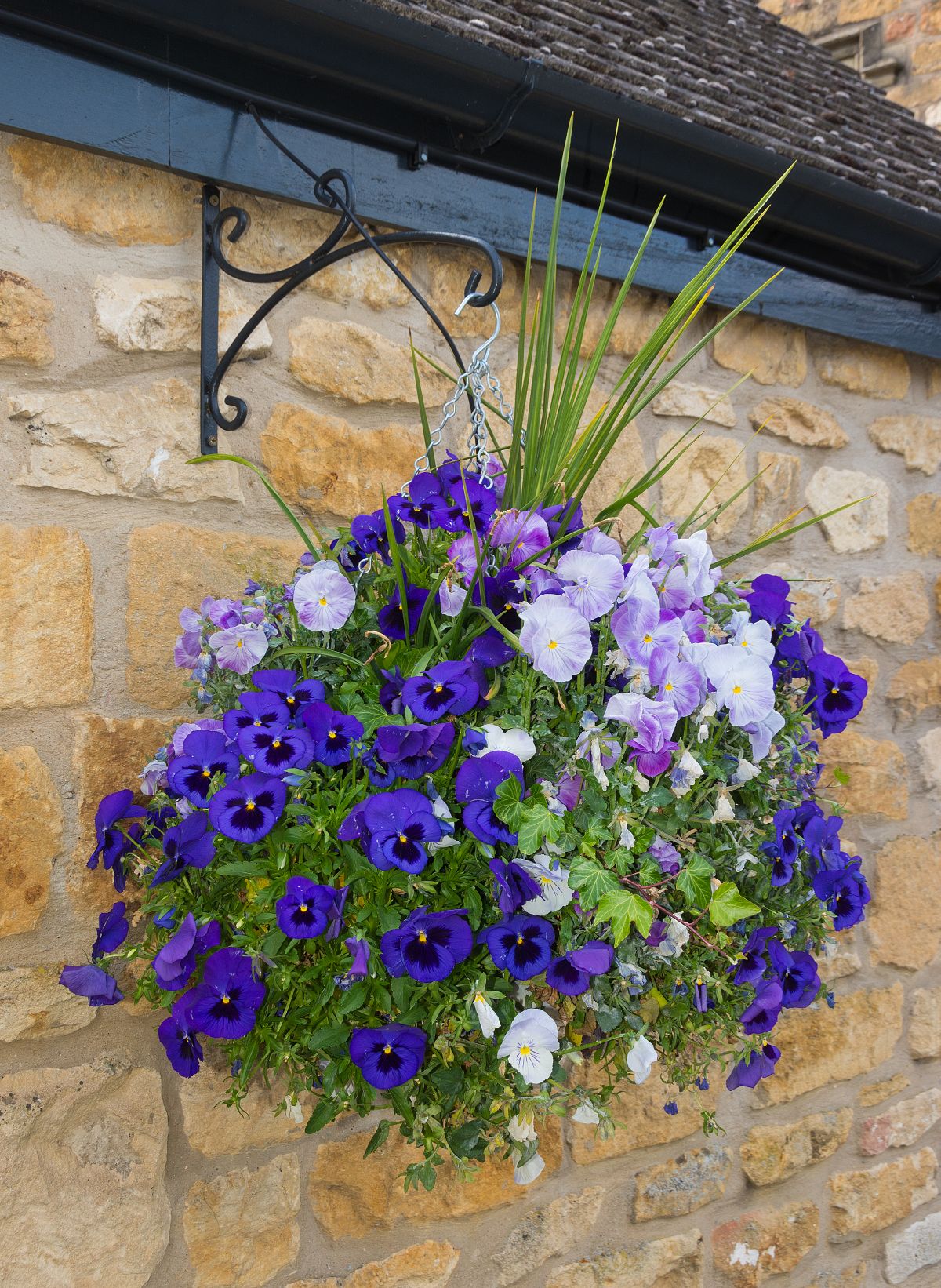
| Plant name: | Trailing pansies |
| Light requirements: | Full sun to part shade |
| Water requirements: | Moderate |
| Bloom time: | Spring to fall (may stop flowering in hot weather) |
Most gardeners are familiar with pansies, which are commonly grown in flower beds and garden borders. But if you love the cheerful faces and bold colors of upright pansy plants, you may also want to try your hand at growing trailing pansies in hanging baskets. A relatively new addition to the gardening world, trailing pansies were only developed a few years ago, but they’re becoming increasingly popular because of their low maintenance needs and sunny disposition!
Like standard pansies, trailing pansies can adapt to full sun or shade, but they do need to be watered regularly to keep them looking their best. These plants are short-lived perennials, and they can overwinter in even chilly zone 4, although they may go dormant when temperatures drop.
7. Geraniums (Pelargonium zonale)
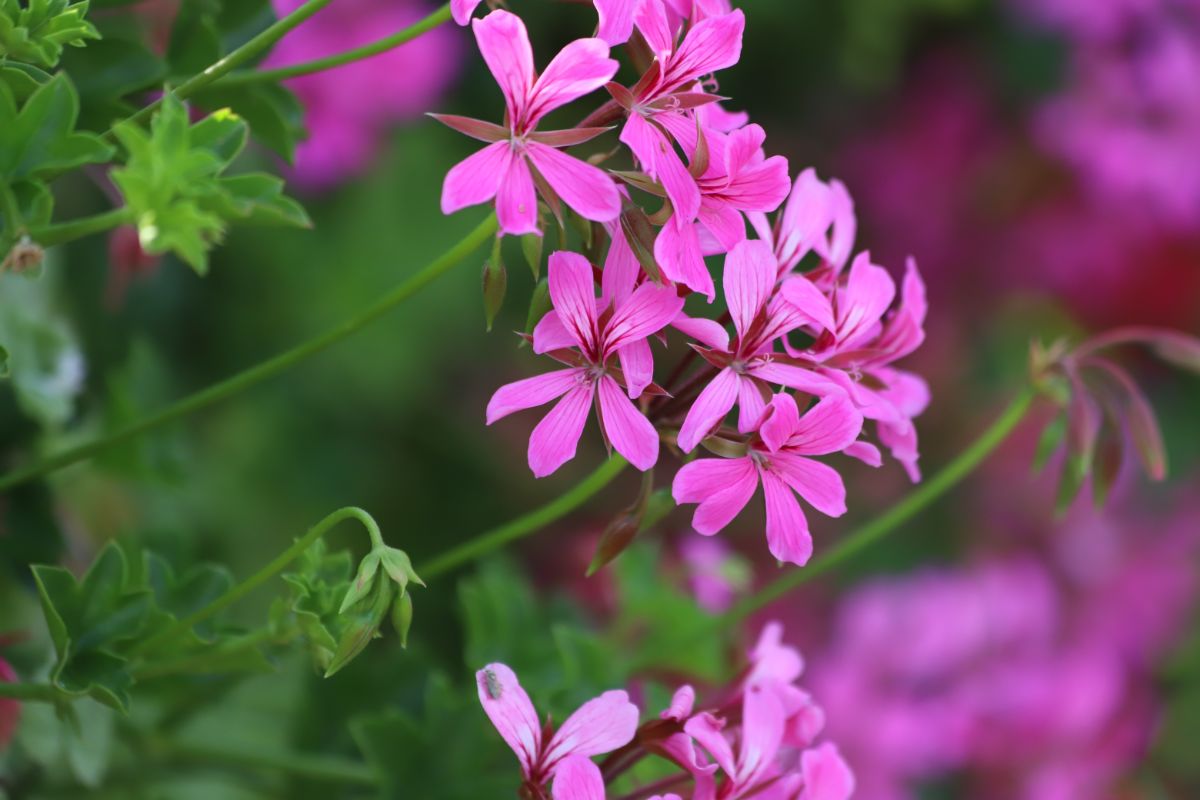
| Plant name: | Geraniums |
| Light requirements: | Full sun |
| Water requirements: | Moderate |
| Bloom time: | Spring to fall |
If you take a drive down a neighborhood street in summer, chances are you’ll see at least one porch planter or hanging basket filled with geranium plants. Geraniums are another wildly popular choice for hanging baskets, but they can also be grown in window boxes and garden beds too. Most growers cherish geraniums due to their showy blooms, but these plants are naturally resistant to most pests, and they’re super easy to keep.
North America has its own native, wild geraniums, but the zonal geranium originates in South Africa. This geranium type is the most classic choice for hanging baskets, and you can find plants with bright crimson, pink, or white blooms. When zonal geranium flowers start to fade, they should be deadheaded (stems and all!) to give the plant more energy to produce more flowers.
8. Sweet alyssum (Lobularia maritima)
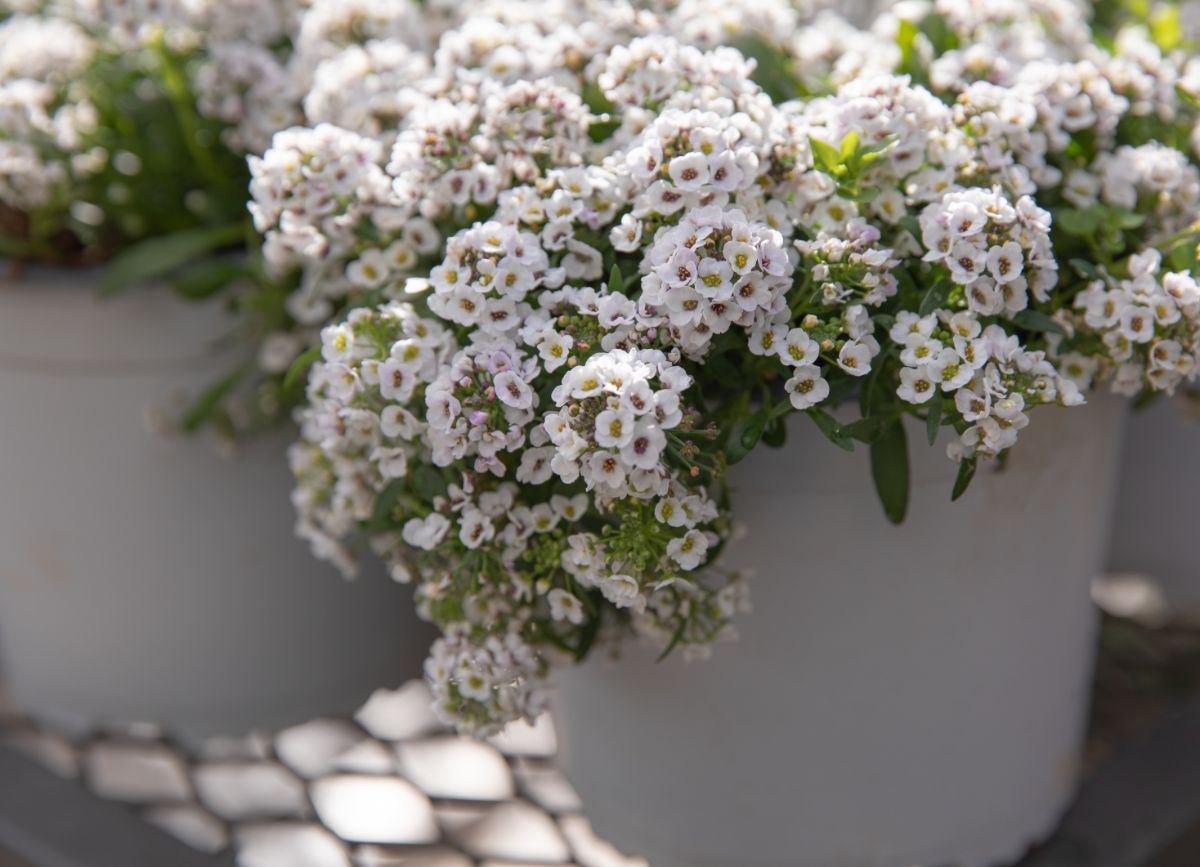
| Plant name: | Sweet alyssum |
| Light requirements: | Full sun to part shade |
| Water requirements: | Moderate |
| Bloom time: | Spring to fall (may stop flowering in hot weather) |
A top-notch pollinator plant, sweet alyssum is often used as a companion plant in vegetable gardens to increase pollination rates. But while sweet alyssum is certainly functional, it’s also a stunning ornamental and perfect hanging basket plant!
Sweet alyssum grows low to the ground, and it produces clusters of purple and white flowers that emit a sweet fragrance. During the summer heat, sweet alyssum blooms may fade, but plants recover quickly when temperatures drop in the fall. If you’re looking for a plant to grow in spring and fall, sweet alyssum is hard to beat, and it pairs beautifully with other cool season favorites, like petunias and mums.
9. Begonias (Begonia spp.)

| Plant name: | Begonias |
| Light requirements: | Part shade |
| Water requirements: | Moderate |
| Bloom time: | Spring to fall |
Begonias come in all shapes and sizes, and you find massive cane-type begonias that grow over 6’ tall! But for hanging baskets, you’ll probably want to stick to smaller, cascading begonia varieties or colorful plants like rex begonias.
Begonias are some of the best foliage plants you can find, and some begonia species have speckled or spotted leaves, while others have curious leaves ornamented with colorful spirals. But beyond their foliage, many begonias also produce delicate blooms with pink or white petals, which often flower late in the season. While begonias can be kept as annuals, these plants also transition beautifully to indoor life if you want to keep them as houseplants in winter!
10. Portulaca (Portulaca oleracea)
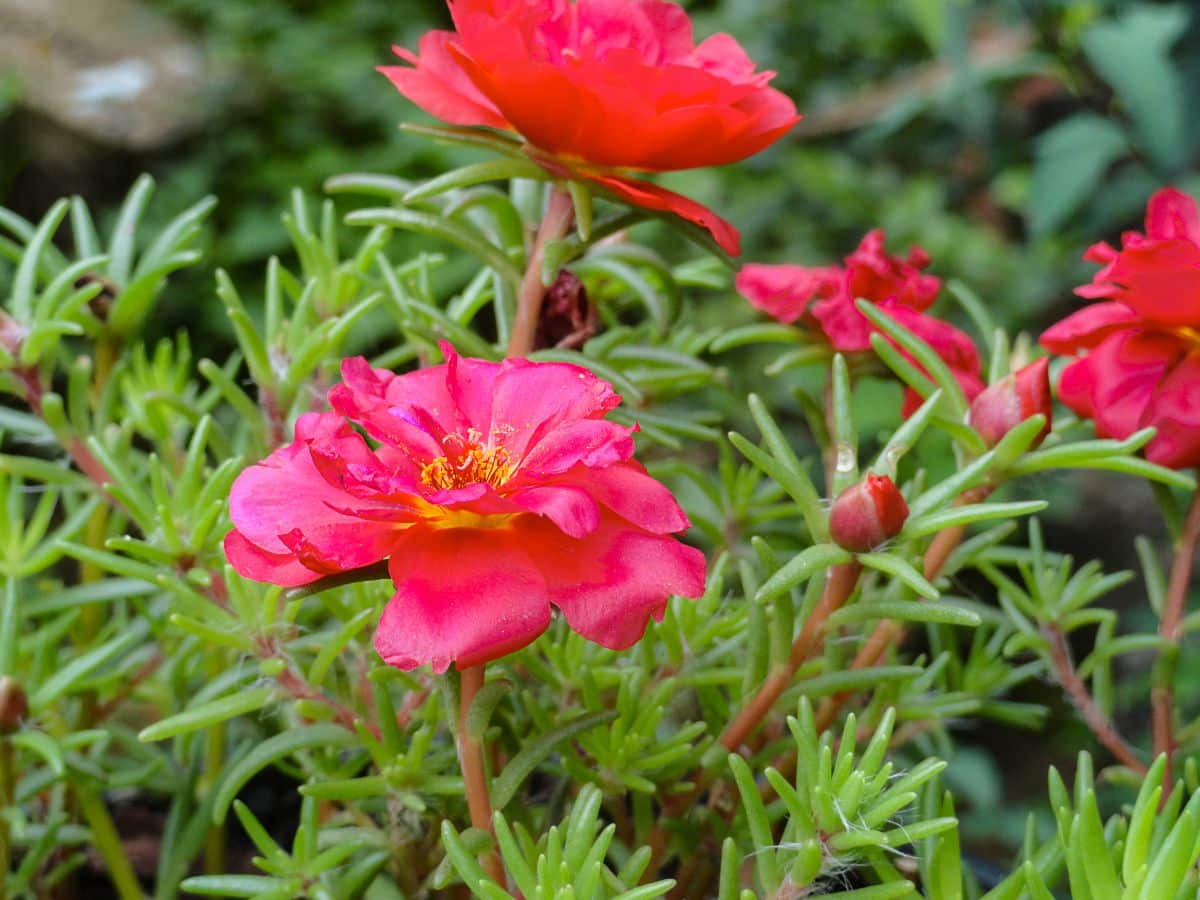
| Plant name: | Portulaca |
| Light requirements: | Full sun |
| Water requirements: | Moderate to low |
| Bloom time: | Summer to frost |
Also known as moss rose, portulaca is native to South America, and it’s drought and heat-resistant thanks to succulent leaves. But while this low-maintenance plant makes a fabulous groundcover, it’s also well adapted to growing in hanging baskets. When fully grown, portulaca grows between 3 and 12” tall, but it can spread over 2’ wide.
Although portulaca has a lot to recommend it, most growers cherish this plant for its colorful, saucer-shaped flowers. Portulaca blooms from summer to fall, and you can find plants with white, red, yellow, orange, salmon, and bicolor blooms. Depending on your growing style, portulaca plants can be started from nursery starts or seeds, but you’ll need to get seeds planted early… about 6 to 8 weeks before your last frost date.
11. Trailing African daisies (Osteospermum fruticosum)
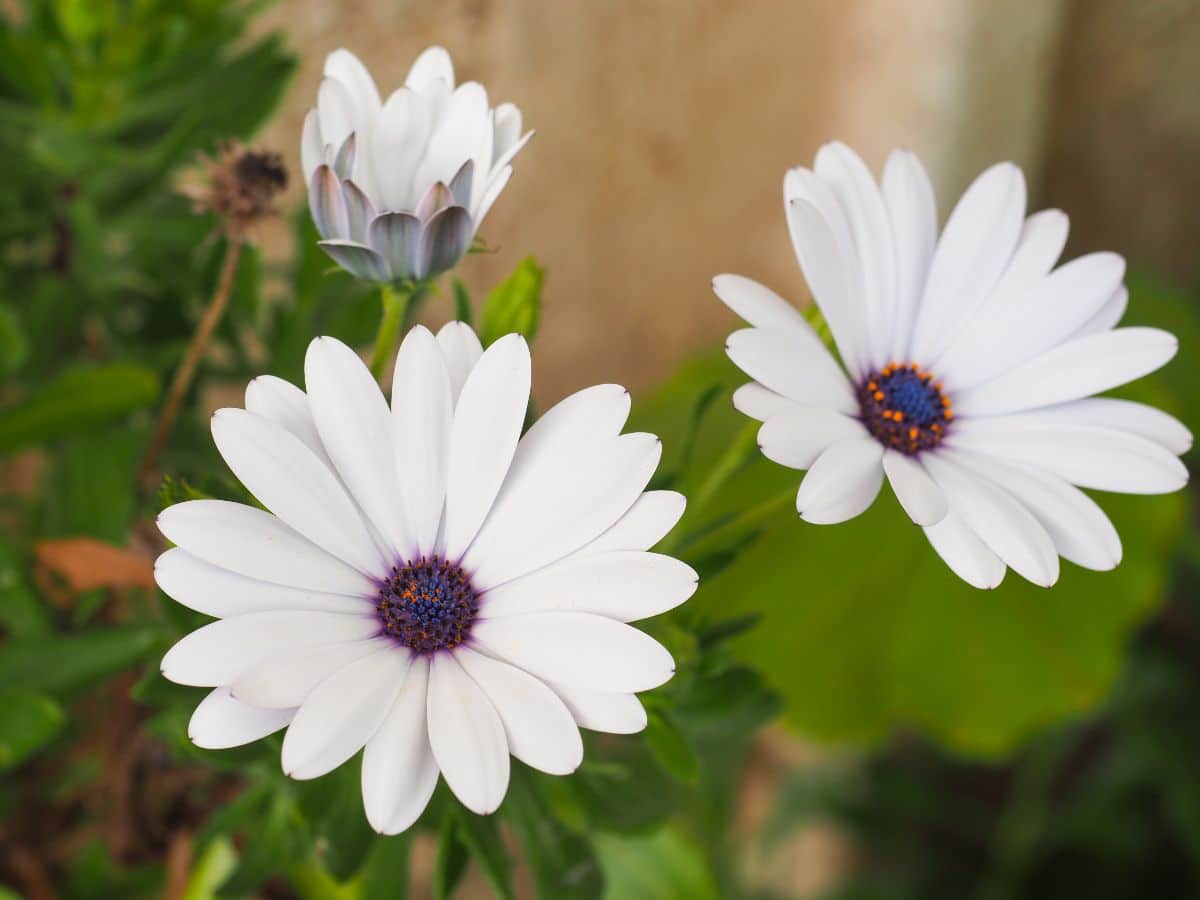
| Plant name: | Trailing African daisies |
| Light requirements: | Full sun |
| Water requirements: | Moderate |
| Bloom time: | Spring to fall (may stop flowering in hot weather) |
African daisies are commonly grown as houseplants, but their brilliant colors can also be used to accentuate porch planters and window boxes. However, if you keep hanging baskets on your patio or porch, you may want to try out trailing African daisies. These charming plants have all of the allure of upright specimens, but their cascading growth habit looks even better when hung up high!
With a blend of purple, yellow, and white blooms, trailing African daisies have enough ornamental appeal to serve as the “thriller” element in planting arrangements. But you can also use these plants as “spillers” and pair them with upright foliage plants like dusty miller or dracaena. However you choose to grow them, trailing African daisies will reward you with blooms from summer into fall, and you can even keep these plants as houseplants, too!
12. Lantana (Lantana spp.)
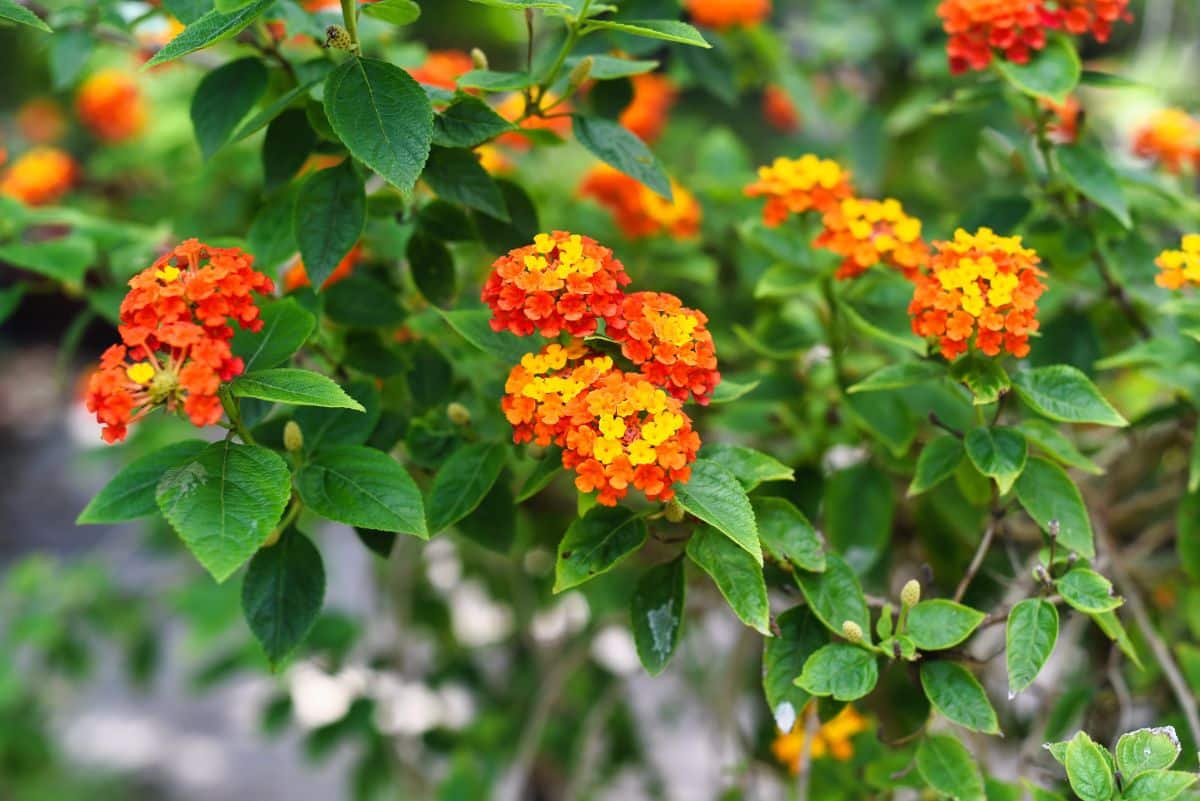
| Plant name: | Lantana |
| Light requirements: | Full sun to part shade |
| Water requirements: | Moderate |
| Bloom time: | Spring to frost |
Lantanas look like a miniature sunset with their clustered array of pink, orange, and yellow blooms. During the summer, lantana flowers are highly attractive to hummingbirds, but bees and other pollinators adore these plants as well. Plus, lantana blooms emit a musky fragrance that’s totally unique but with an afternote of citrus.
For optimal flowering, lantanas need to grow in full sun, so be sure to locate your plants in a sunny section of your property. These plants also thrive in consistently moist soil, but they can develop root rot if they’re overwatered, so make sure you don’t overdo it with your watering can. One way to prevent waterlogged soil is to grow hanging plants in baskets with plenty of drainage holes, but you can also find planters with easy-to-read water gauges that will take all of the guesswork out of watering!
13. Mums (Chrysanthemum spp.)
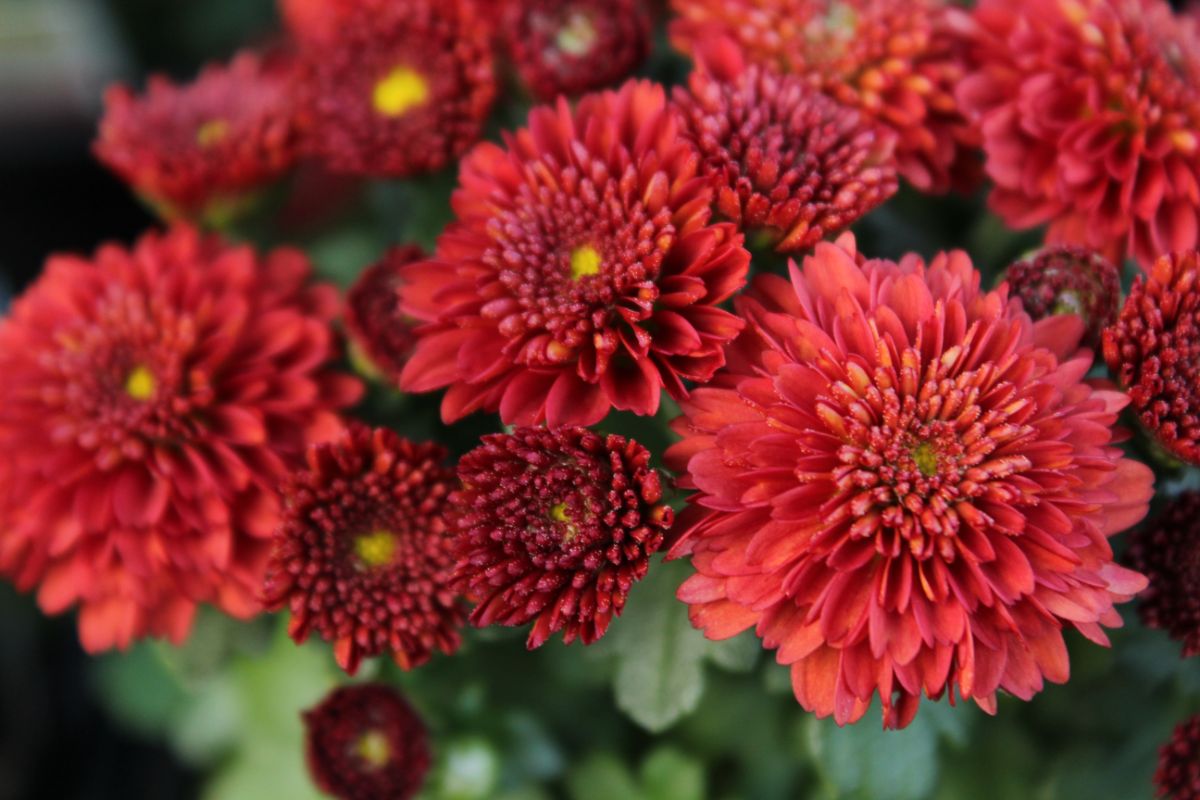
| Plant name: | Mums |
| Light requirements: | Full sun |
| Water requirements: | Moderate |
| Bloom time: | Mid-summer to fall |
A favorite in autumn gardens, mums are commonly grown in porch planters, and they can be sown en masse in gardens for a carpet of late-season blooms. But you can also keep mums of all colors in hanging baskets and light up your porch or patio with brilliant burgundy, purple, yellow, orange, or red flowers!
Mums are often associated with fall because these plants are naturally cold-resistant. But on top of that, mum colors coordinate beautifully with other autumnal décor, such as pumpkins and homegrown gourds. To keep mums looking their best, deadhead spent blooms when they start to fade and protect mums from severe cold snaps by bringing them indoors overnight or covering them up with frost protection blankets.
14. Fuchsia (Fuchsia magellanica)

| Plant name: | Fuchsia |
| Light requirements: | Part shade |
| Water requirements: | High to moderate |
| Bloom time: | Summer to fall |
As becoming as lantanas are, if you’re looking for a different hanging plant to attract hummingbirds, fuchsia is another excellent option. Not only do fuchsia blooms draw in hummingbirds, but these plants are also irresistible to bees and other beneficial insects too. And, of course, fuchsia flowers are totally unique looking with bold magenta and purple coloration that makes them stand out in a crowd!
Fuchsia plants are sometimes grown as houseplants, but they crave high humidity. While humidity is rarely an issue when you keep fuchsia outdoors in hanging baskets, if you bring your plants inside during the winter, you’ll want to keep them near a humidifier to boost moisture levels. Outdoor fuchsia plants grow best in moist soil, and plants may need to be watered once or twice a day in summer when temperatures are high.
15. Boston fern (Nephrolepis exaltata)
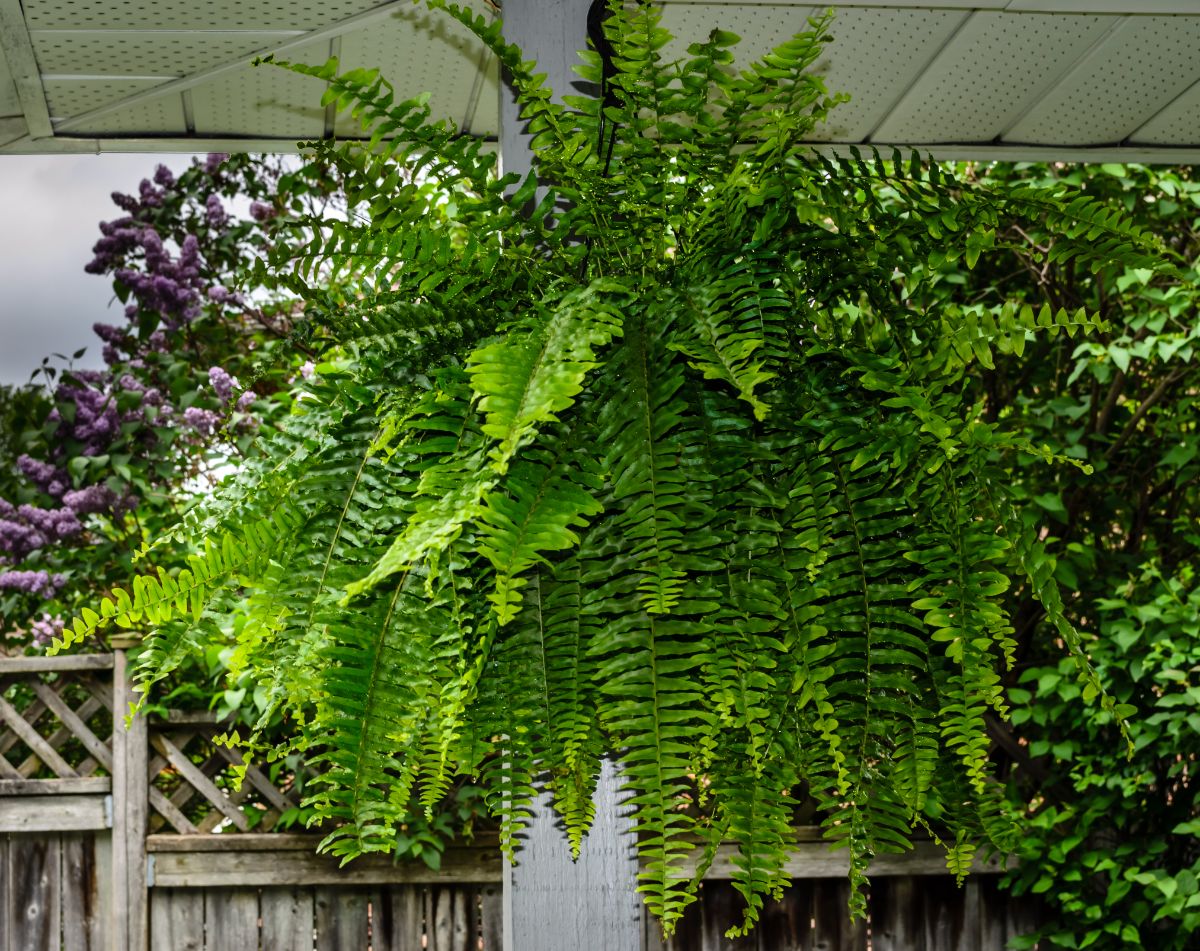
| Plant name: | Boston fern |
| Light requirements: | Part shade |
| Water requirements: | High |
| Bloom time: | N/A |
Another plant that’s commonly grown as a houseplant, Boston ferns lend a traditional feel to porch planters and hanging baskets. While they don’t boast the showy blooms of some of the other plants on this list, Boston ferns are still plenty colorful, thanks to their vivid green leaves. Even better, Boston ferns thrive in shady areas where many flowering plants struggle to grow!
Well-maintained Boston ferns can get quite massive, and plants can easily spread over 3’ tall and as many feet wide. When kept in hanging planters, Boston ferns tend to develop a tidy, globe-like form, but you can keep them even more pristine by snipping away any leaves that start to brown. Like other ferns, Boston ferns need moist soil, but they shouldn’t be watered so often that their pots get soggy.
16. Bacopa (Sutera cordata)
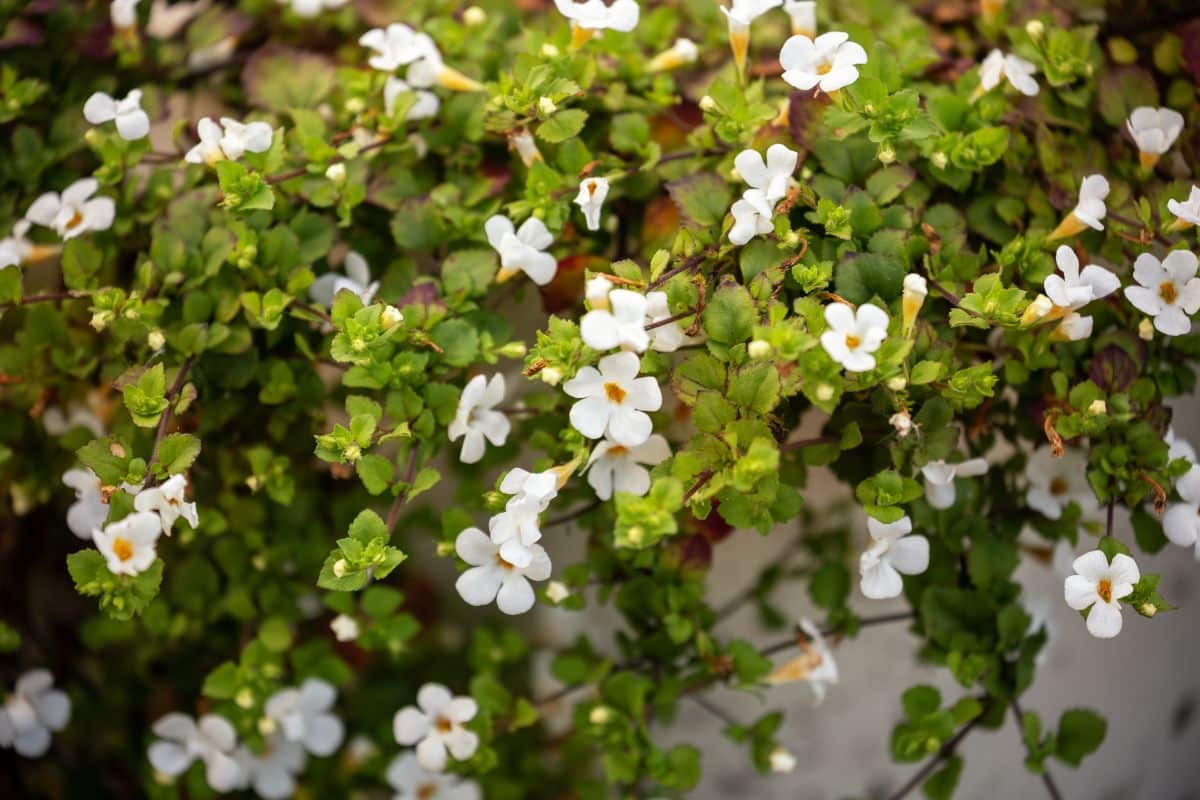
| Plant name: | Bacopa |
| Light requirements: | Full sun to part shade |
| Water requirements: | High to moderate |
| Bloom time: | Late spring to frost |
Bacopa is a cascading beauty that blooms reliably from summer through early fall. The flowers of these plants are usually white, but you can find plants with blue, pink, and purple flowers as well. Most of the time, bacopa plants have deep green leaves, but some varieties produce golden-tinged or variegated leaves instead.
Blooming right up until the frosts of fall, bacopa plants can tolerate full sun or part shade, but flowers may die back during the summer heat. Not to worry, though. Bacopa flowers typically recover by autumn, or you can find heat-resistant cultivars that are less perturbed by hot weather!
17. Burro’s tail (Sedum morganianum)
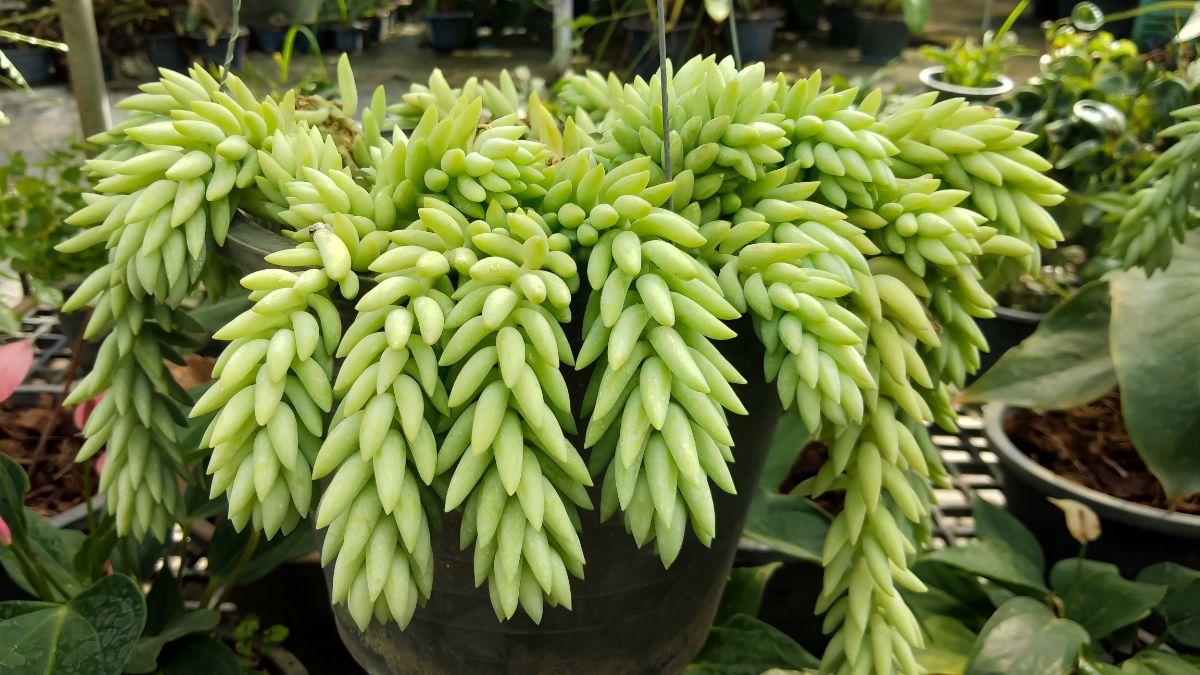
| Plant name: | Burro’s tail |
| Light requirements: | Full sun |
| Water requirements: | Low |
| Bloom time: | Summer |
Burro’s tail is a unique choice for hanging baskets, but it may be a particularly appealing option if you live in an arid climate. That’s because burro’s tail is a succulent plant, and it can handle drought-like conditions with ease. In fact, the one thing you want to avoid with burro’s tail is “over loving” and overwatering them.
Burro’s tail is mostly cultivated for its fleshy leaves that have a lovely blueish-green coloration. But when burro’s tail plants are grown outdoors in sunny spots, they can occasionally flower, too. And while burro’s tail can be grown as an annual, you can also bring these plants indoors in cold weather and keep them as low-maintenance houseplants!
18. Asparagus fern (Asparagus setaceus)
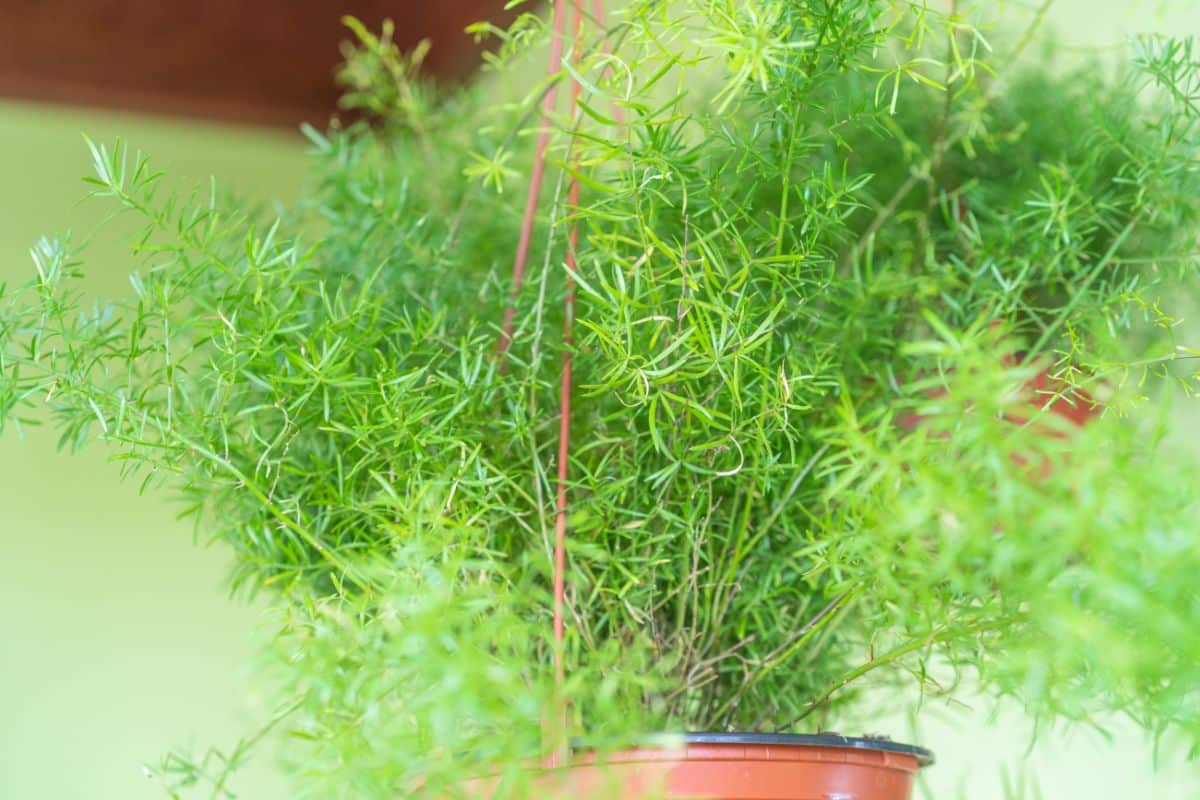
| Plant name: | Asparagus fern |
| Light requirements: | Full sun to part shade |
| Water requirements: | High to moderate |
| Bloom time: | Spring to fall |
Asparagus ferns aren’t actually ferns, but they have that light and airy feel that fern enthusiasts adore. In actuality, asparagus ferns are more closely related to asparagus and lilies, and they’re kept primarily as foliage plants. But while asparagus ferns look soft to the touch, keep in mind that they have tiny thorns on their stems that can prick your fingers if you’re not careful!
When mature, asparagus ferns will sometimes flower and produce red berries; however, these plants are not edible, and they’re toxic to pets. That said, asparagus ferns are relatively easy to keep, and you can bring them indoors as houseplants in winter if you want to keep them growing. Compared to true ferns, asparagus ferns don’t need to be watered as often, but they do still like to be watered regularly.
Frequently asked questions
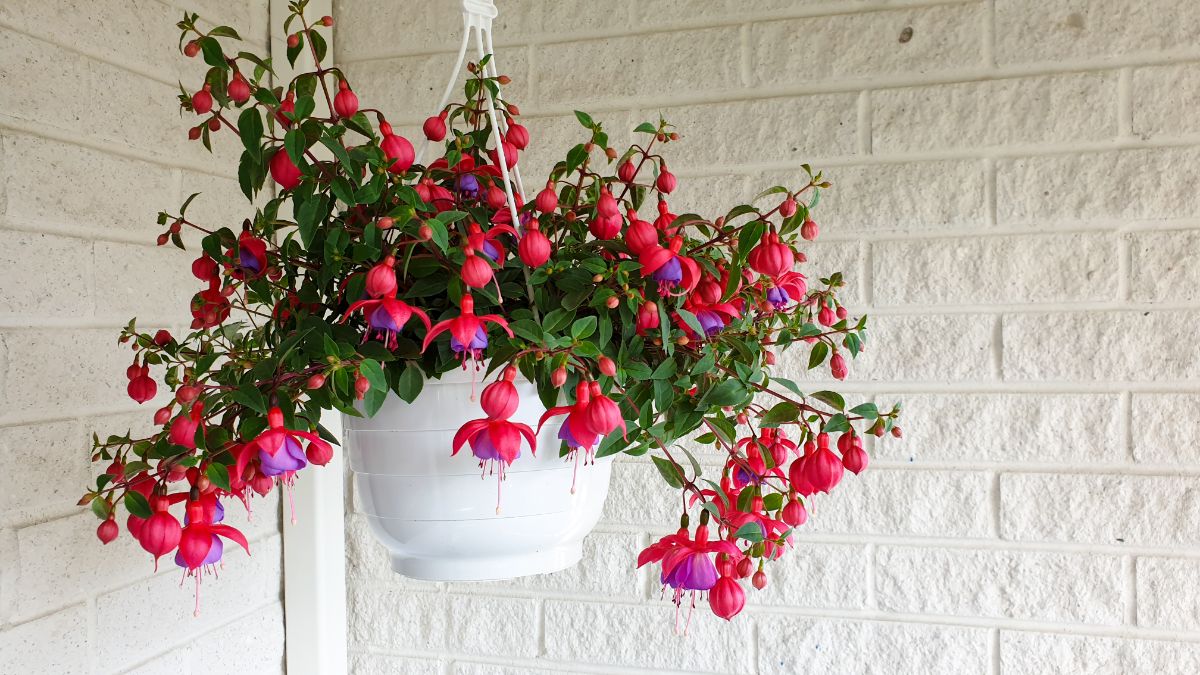
What can I hang on my front porch instead of flowers?
Ferns and asparagus ferns are popular choices for hanging baskets if you don’t want to grow flowering plants on your porch. Trailing succulents like burro’s tail and string of pearls can also make striking hanging plants, and you can even bring them indoors and keep them as houseplants at the end of the season!
How do you hang plants on a porch?
Most commonly, hanging baskets are hung from hooks that are screwed into porch roofs and railings. If your porch roof creates too much shade, you can lower your plants so that they’re in more sun with extension hooks, chains, or a length of rope.
What hanging plants don't need much water?
Trailing succulents, like burro’s tail, are the best choice if you want a low-maintenance porch plant that needs minimal watering. While many flowering plants can get by with little water in garden beds, plants kept in hanging pots will dry out much more quickly, and they will need to be watered often, especially in summer.
Is there a way to hang plants without drilling?
Yes! If you love the idea of keeping hanging plants on your porch but you don’t want to screw hooks into your porch roof, you can also install deck hooks that screw onto a deck and porch railings. These handy hangers can be used to support plants, but you can also utilize them to hold up windchimes, bird feeders, and hummingbird feeders.
What hanging plants can take full sun and heat?
Many flowering plants grow well in full sun, including million bells and petunias. Heat-tolerant plants, like burro’s tail, are also fine choices for porches and patios that get lots of hot sun.
What hanging plants don't need much sun?
Most ferns grow well in part shade, and impatiens also crave lower light areas. If you grow these plants in a sunny spot, they may develop sun scorch, which is never a good thing!
Summary
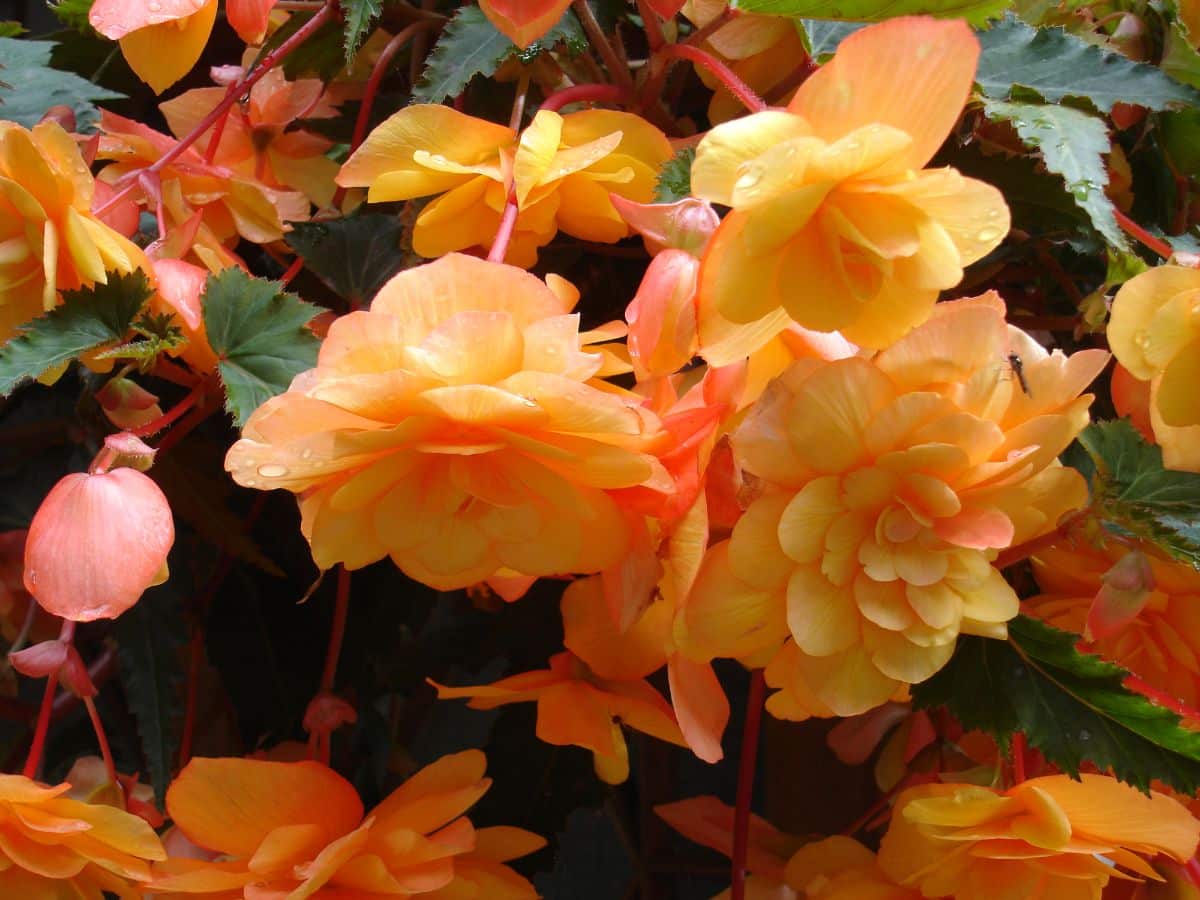
Porch planters are nice, and window boxes are charming, but if you want to spruce up your front porch or patio with a decadent splash of color, hanging baskets bursting with summertime blooms are hard to beat. Today, there are many different flowering annuals to choose from, as well as foliage plants and tough-as-nail succulents that need minimal water. The hardest part is choosing which fantastic hanging plant will work best for you!
We hope you enjoyed this exploration into trailing annual plants, but for even more planting ideas, check out our guide on cold hardy annuals that can tolerate frost.

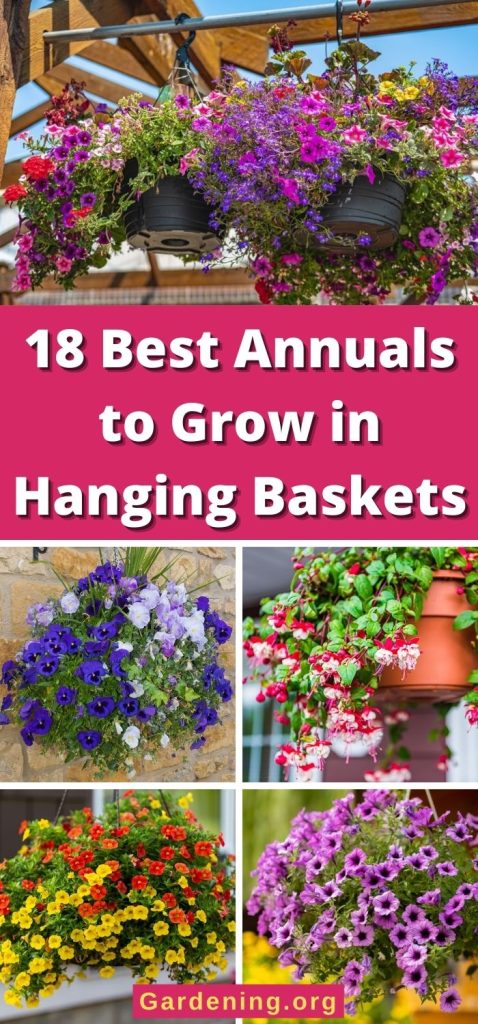
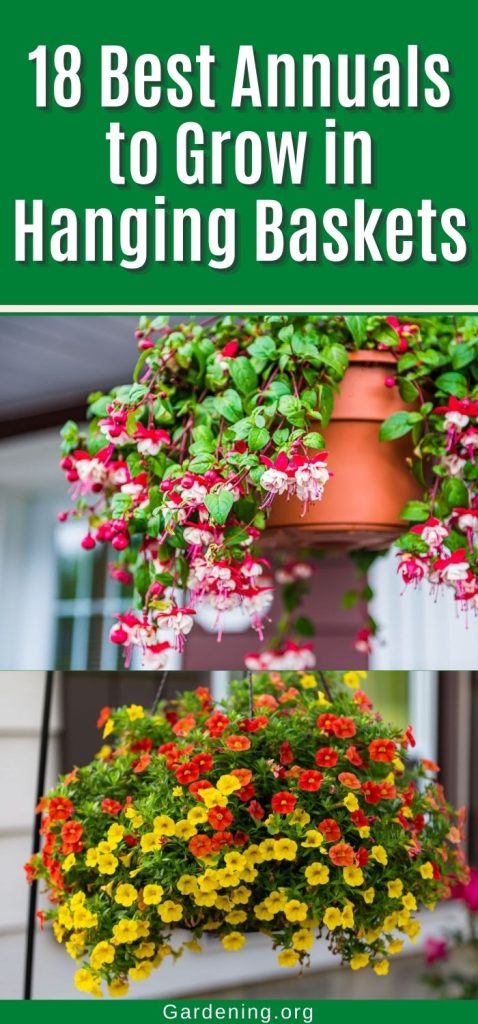

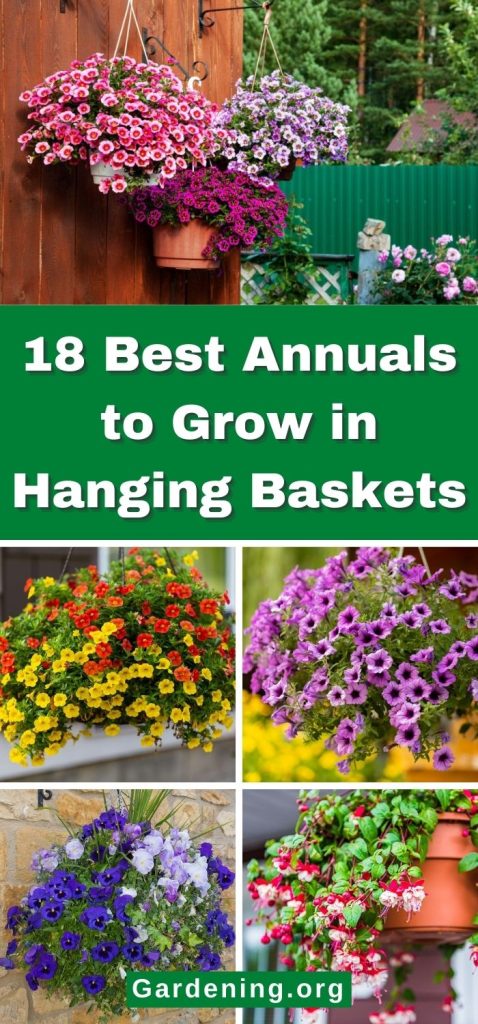

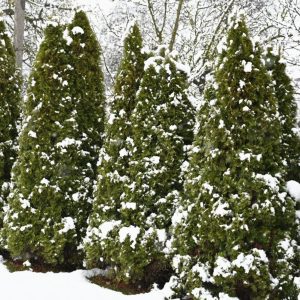


Kym Dennhardt Whatley
Wonderful and informative 👍 Thank you 😊